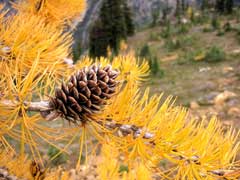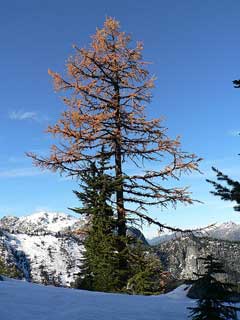 |
|
http://commons.wikimedia.org/wiki/User:Wsiegmund |
 |
| http://commons.wikimedia.org/wiki/User:Wsiegmund |
Translate this page:
Summary
Physical Characteristics

 Larix lyallii is a deciduous Tree growing to 25 m (82ft 0in).
Larix lyallii is a deciduous Tree growing to 25 m (82ft 0in).
See above for USDA hardiness. It is hardy to UK zone 3 and is not frost tender. The species is hermaphrodite (has both male and female organs).
Suitable for: light (sandy), medium (loamy) and heavy (clay) soils. Suitable pH: mildly acid, neutral and basic (mildly alkaline) soils. It can grow in semi-shade (light woodland) or no shade. It prefers moist soil.
UK Hardiness Map
US Hardiness Map
Synonyms
Plant Habitats
Woodland Garden Canopy;
Edible Uses
Edible Parts: Leaves Shoots
Edible Uses:
The shoot-tips are used as a flavouring in soups[177].
References More on Edible Uses
Medicinal Uses
Plants For A Future can not take any responsibility for any adverse effects from the use of plants. Always seek advice from a professional before using a plant medicinally.
None known
References More on Medicinal Uses
The Bookshop: Edible Plant Books
Our Latest books on Perennial Plants For Food Forests and Permaculture Gardens in paperback or digital formats.

Edible Tropical Plants
Food Forest Plants for Hotter Conditions: 250+ Plants For Tropical Food Forests & Permaculture Gardens.
More

Edible Temperate Plants
Plants for Your Food Forest: 500 Plants for Temperate Food Forests & Permaculture Gardens.
More

More Books
PFAF have eight books available in paperback and digital formats. Browse the shop for more information.
Shop Now
Other Uses
Tannin Wood
The bark contains tannin[229]. Wood - strong, heavy, hard, coarse-grained and durable[82, 229].
Special Uses
References More on Other Uses
Cultivation details
Prefers an open airy position in a light or gravelly well-drained soil[200]. Intolerant of badly drained soils, but tolerates acid and infertile soils[200]. Succeeds on rocky hill or mountain sides and slopes[200]. A north or east aspect is more suitable than west or south[1]. This species is very cold-hardy when fully dormant, but the trees can be excited into premature growth in Britain by mild spells during the winter and they are then very subject to damage by late frosts and cold winds[1]. Plants are not very successful in Britain, they have been tried on many occasions but have failed to make a satisfactory tree[11, 185]. A specimen at the Hillier Arboretum was 4.5 metres tall in 1970 and suffered frost damage each year[185]. This species is impossible to grow in lowland Britain, though it should succeed above a height of 300 metres in the eastern Scottish Highlands[200]. Growth is normally slow in Britain with average height increases of less than 30cm per year[185]. Hybridizes freely with other members of this genus[200]. Closely related to L. occidentalis[200]. Open ground plants, 1 year x 1 year are the best for planting out, do not use container grown plants with spiralled roots[200]. Plants transplant well, even when coming into growth in the spring[200]. Plants in this genus are notably resistant to honey fungus[200].
References Carbon Farming Information and Carbon Sequestration Information
Temperature Converter
Type a value in the Celsius field to convert the value to Fahrenheit:
Fahrenheit:
The PFAF Bookshop
Plants For A Future have a number of books available in paperback and digital form. Book titles include Edible Plants, Edible Perennials, Edible Trees,Edible Shrubs, Woodland Gardening, and Temperate Food Forest Plants. Our new book is Food Forest Plants For Hotter Conditions (Tropical and Sub-Tropical).
Shop Now
Plant Propagation
Seed - sow late winter in pots in a cold frame. One months cold stratification helps germination[113]. It is best to give the seedlings light shade for the first year[78]. As soon as they are large enough to handle, prick out the seedlings into individual pots. Although only a few centimetres tall, they can be planted out into their permanent positions in the summer providing you give them an effective weed-excluding mulch and preferably some winter protection for their first year. Otherwise grow them on in the cold frame for their first winter and plant them out in early summer of the following year. The seed remains viable for 3 years[113] If you are growing larger quantities of plants, you can sow the seed in an outdoor seedbed in late winter. Grow on the seedlings in the seedbed for a couple of years until they are ready to go into their permanent positions then plant them out during the winter.
Other Names
If available other names are mentioned here
Native Range
NORTHERN AMERICA: Canada (Alberta (southwest), British Columbia (south)), United States (Idaho (north), Montana (west), Washington)
Weed Potential
Right plant wrong place. We are currently updating this section.
Please note that a plant may be invasive in one area but may not in your area so it's worth checking.
Conservation Status
IUCN Red List of Threatened Plants Status :

Growth: S = slow M = medium F = fast. Soil: L = light (sandy) M = medium H = heavy (clay). pH: A = acid N = neutral B = basic (alkaline). Shade: F = full shade S = semi-shade N = no shade. Moisture: D = dry M = Moist We = wet Wa = water.
Now available:
Food Forest Plants for Mediterranean Conditions
350+ Perennial Plants For Mediterranean and Drier Food Forests and Permaculture Gardens.
[Paperback and eBook]
This is the third in Plants For A Future's series of plant guides for food forests tailored to
specific climate zones. Following volumes on temperate and tropical ecosystems, this book focuses
on species suited to Mediterranean conditions—regions with hot, dry summers and cool, wet winters,
often facing the added challenge of climate change.
Read More
Expert comment
Author
Parl.
Botanical References
1160200
Links / References
For a list of references used on this page please go here
Readers comment
| Add a comment |
|
If you have important information about this plant that may help other users please add a comment or link below. Only comments or links that are felt to be directly relevant to a plant will be included. If you think a comment/link or information contained on this page is inaccurate or misleading we would welcome your feedback at [email protected]. If you have questions about a plant please use the Forum on this website as we do not have the resources to answer questions ourselves.
* Please note: the comments by website users are not necessarily those held by PFAF and may give misleading or inaccurate information.
To leave a comment please Register or login here All comments need to be approved so will not appear immediately.
|
|